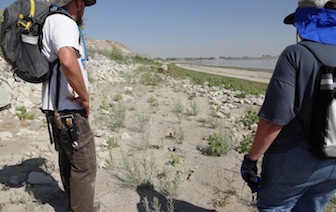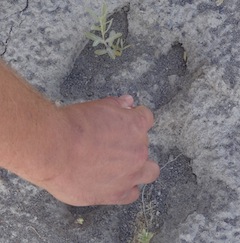Idaho State University scientists, students explore ancient tracks discovered at American Falls Reservoir
September 10, 2013
Idaho State University scientists, graduate and undergraduate students are piecing together ancient animal tracks that date back 10,000 to 200,000 years ago along the American Falls Reservoir.
 The recently discovered tracks come from a variety of ancient animals including the Camelops hesternus (yesterday's camel), Hemiauchenia macrocephala (big-headed llamas) and Canis dirus (dire wolf). All of these animals lived during the Pleistocene Era, or "Ice Age."
The recently discovered tracks come from a variety of ancient animals including the Camelops hesternus (yesterday's camel), Hemiauchenia macrocephala (big-headed llamas) and Canis dirus (dire wolf). All of these animals lived during the Pleistocene Era, or "Ice Age."
Along with the tracks, bones from bison, horses, camels and llamas were also discovered in the area by ISU students, Jeff Castro and Adam Clegg, who are working on the project with Mary Thompson of the Idaho Museum of Natural History at Idaho State University.
 Thompson has been working with Robert Schlader, manager of the Idaho Virtualization Lab at the Idaho Museum of Natural History; Bureau of Reclamation archeologist Jenny Huang; and about a dozen student interns to carefully document the discovery.
Thompson has been working with Robert Schlader, manager of the Idaho Virtualization Lab at the Idaho Museum of Natural History; Bureau of Reclamation archeologist Jenny Huang; and about a dozen student interns to carefully document the discovery.
ISU’s experts are working carefully with the Bureau of Reclamation to survey and protect these resources. In 2009, a federal law passed that made it illegal for people to remove fossils and other finds from federal land which includes the 21-mile long reservoir above American Falls.
Schlader and undergraduate students, Jesse Pruitt and Kate DeHart, have set up a sophisticated 3-D imaging device that uses lasers and a rotating mirror to create a three dimensional image of the walkway and measures distance. Once the device has gathered all the data, Schlader will take it back to his lab and re-create a virtual track-way.
This will help Thompson and other researchers to examine the lifestyle of these animals and the environment that existed between 10,000 and 200,000 years ago when the ancient animals were alive.
Another method used in the field is acetate rendering to measure individual prints and the distances between each print, as well as the direction of the tracks. Once all other forms of documentation are performed, the last documentation process is to take latex molds of each print. This is done after all other processes in case the molds destroy the tracks. Thompson explained that with the 3-D model, the museum could re-create a 3-D print of the track-ways for future research or for future museum displays.
"We are excited to have found these ancient tracks and bones," said Thompson. "We encourage the public to contact the museum if they find anything."
 The American Falls Reservoir sediments contain two fossiliferous layers representing two different time periods that have been carefully studied since the 1930s and 1940s. The first track-ways were discovered in 2010 of horse and big cat prints, along with Proboseidean (mammoth or mastodon) tracks. In 2012 another track way was discovered that included camel, bison, and big cat tracks. The museum currently holds more than 150,000 fossils from the reservoir area alone.
The American Falls Reservoir sediments contain two fossiliferous layers representing two different time periods that have been carefully studied since the 1930s and 1940s. The first track-ways were discovered in 2010 of horse and big cat prints, along with Proboseidean (mammoth or mastodon) tracks. In 2012 another track way was discovered that included camel, bison, and big cat tracks. The museum currently holds more than 150,000 fossils from the reservoir area alone.
For more information about Idaho Museum of Natural History and updates visit http://imnh.isu.edu.
###
Categories:
